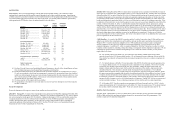Dish Network 2012 Annual Report Download - page 8
Download and view the complete annual report
Please find page 8 of the 2012 Dish Network annual report below. You can navigate through the pages in the report by either clicking on the pages listed below, or by using the keyword search tool below to find specific information within the annual report.4
4
Distribution Channels
While we offer receiver systems and programming through direct sales channels, a majority of our new subscriber
activations are generated through independent third parties such as small satellite retailers, direct marketing groups,
local and regional consumer electronics stores, nationwide retailers, and telecommunications companies. In general,
we pay these independent third parties a mix of upfront and monthly incentives to solicit orders for our services and
provide customer service. In addition, we partner with certain telecommunications companies to bundle DISH
branded programming with broadband and/or voice services on a single bill.
Competition
As of December 31, 2012, our 14.056 million subscribers represent approximately 14% of pay-TV subscribers in the
United States. We face substantial competition from established pay-TV providers and increasing competition from
companies providing/facilitating the delivery of video content via the Internet to computers, televisions, and mobile
devices. As of September 30, 2012, more than 100 million households subscribe to a pay-TV service.
x Other Direct Broadcast Satellite Operators. We compete directly with the DirecTV Group, Inc., or
DirecTV, the largest satellite TV provider in the U.S. which had 20.0 million subscribers as of September
30, 2012, representing approximately 20% of pay-TV subscribers.
x Cable Television Companies. We encounter substantial competition in the pay-TV industry from numerous
cable television companies that operate via franchise licenses across the U.S. According to the National
Cable & Telecommunications Association, 99% of U.S. housing units are passed by cable. As of
September 30, 2012, cable television companies have more than 56.8 million subscribers, representing
approximately 57% of pay-TV subscribers. Cable companies are typically able to bundle their video
services with broadband Internet access and voice services and many have significant investments in
companies that provide programming content.
x Telecommunications Companies. Large telecommunications companies have upgraded older copper wire
lines with fiber optic lines in certain markets. These fiber optic lines provide high capacity bandwidth,
enabling telecommunications companies to offer video content that can be bundled with their broadband
Internet access and voice services. In particular, AT&T and Verizon have built fiber-optic based networks
to provide video services in substantial portions of their service areas. As of September 30, 2012, AT&T
and Verizon had approximately 4.3 million U-verse and 4.6 million FiOS TV subscribers, respectively.
These telecommunications companies represent approximately 9% of pay-TV subscribers.
x Internet Delivered Video. We face competition from content providers and other companies who distribute
video directly to consumers over the Internet. Programming offered over the Internet has become more
prevalent as the speed and quality of broadband networks have improved. Significant changes in consumer
behavior with regard to the means by which they obtain video entertainment and information in response to
this emerging digital media competition could materially adversely affect our business, results of
operations and financial condition or otherwise disrupt our business.
x Wireless Mobile Video. We may also face increasing competition from wireless telecommunications
providers who offer mobile video offerings. These mobile video offerings will likely become more
prevalent in the marketplace as wireless telecommunications providers implement and expand the fourth
generation of wireless communications.
Acquisition of New Subscribers
We incur significant upfront costs to acquire subscribers, including advertising, retailer incentives, equipment
subsidies and installation. In addition, customer promotions to acquire new subscribers result in less programming
revenue to us over the promotional period. While we attempt to recoup these upfront costs over the lives of their
subscriptions, there can be no assurance that we will. We employ business rules such as credit requirements and
contractual commitments, and we strive to provide outstanding customer service, to increase the likelihood of
5
5
customers keeping their DISH service over longer periods of time. Our subscriber acquisition costs may vary
significantly from period to period.
Advertising. We use print, radio, television and Internet media, on a local and national basis to motivate potential
subscribers to call DISH, visit our website or contact independent third party retailers.
Retailer Incentives. In general, we pay retailers an upfront incentive for each new subscriber they bring to DISH
that results in the activation of qualified programming and generally pay retailers small monthly incentives for up to
60 months; provided, among other things: (i) the retailer continuously markets, promotes and solicits orders for
DISH products and services; (ii) the retailer continuously provides customer service to DISH pay-TV subscribers;
and (iii) the customer continuously subscribes to qualified programming.
Equipment. We incur significant upfront costs to provide our new subscribers with in-home equipment, including
advanced HD and DVR receivers, which most of our new subscribers lease from us. While we seek to recoup these
upfront equipment costs mostly through monthly fees, there can be no assurance that we will be successful in
achieving that objective. In addition, upon deactivation of a subscriber we may refurbish and redeploy their
equipment which lowers future upfront costs. However, our ability to capitalize on these cost savings may be
limited as technological advances and consumer demand for new features may render the returned equipment
obsolete.
Installation. We incur significant upfront costs to install satellite dishes and receivers in the homes of our new
customers.
New Customer Promotions. We often offer programming at no additional charge and/or promotional pricing during
introductory periods for new subscribers. While such promotional activities have an economic cost and reduce our
subscriber-related revenue, they are not included in our definitions of subscriber acquisition costs or the SAC metric.
Customer Retention
We incur significant costs to retain our existing customers, mostly by upgrading their equipment to HD and DVR
receivers. As with our subscriber acquisition costs, our retention upgrade spending includes the cost of equipment
and installation. In certain circumstances, we also offer programming at no additional charge and/or promotional
pricing for limited periods for existing customers in exchange for a contractual commitment. A component of our
retention efforts includes the installation of equipment for customers who move. Our subscriber retention costs may
vary significantly from period to period.
Customer Service
Customer Service Centers. We use both internally-operated and outsourced customer service centers to handle calls
from prospective and existing customers. We strive to answer customer calls promptly and to resolve issues
effectively on the first call. We intend to better use the Internet and other applications to provide our customers with
more self-service capabilities over time. During the first quarter 2012, we implemented new sales and customer care
systems to improve the customer experience. In addition, during 2011, we implemented a new interactive voice
response system.
Installation and Other In-Home Service Operations. High-quality installations, upgrades, and in-home repairs are
critical to providing good customer service. Such in-home service is performed by both DISH Network employees
and a network of independent contractors and includes, among other things, priority technical support, replacement
equipment, cabling and power surge repairs for a monthly fee. During 2011, we implemented a new in-home
appointment scheduling system.
Subscriber Management. We presently use, and depend on, CSG Systems International, Inc.’s (“CSG”) software
system for the majority of DISH Network subscriber billing and related functions. During the first quarter 2012, we
implemented a new billing system with CSG.





















